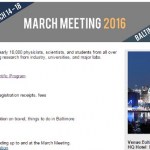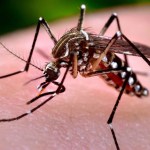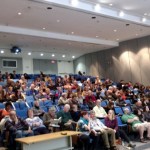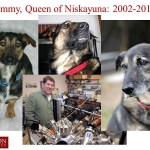Science
I’ve written a lot about the language issue with respect to alternative medicine. As I like to put it (at least in shortened form), first there was quackery. Quacks did not like that name at all, and thus was born alternative medicine. And the quacks did think it good—for a while. There was a problem, however. “Alternative” medicine implied (correctly, of course) that what was being discussed was not real medicine, and the quacks could not abide that. Thus was born “complementary and alternative medicine” (CAM).
And the quacks thought this very good indeed.
Unfortunately, it was not long…
It’s no secret that I’m a big fan of John Oliver. When my aging body allows me to stay awake late enough on Sunday nights and there’s a new episode on, I’ll almost always be watching. Since starting his own show Last Week Tonight With John Oliver on HBO, Oliver’s become quite the expert at using humor to explain and bring attention to injustices that are widely ignored and to skewer politicians and blowhards.
This Sunday, he turned his attention on science reporting:
I certainly would have written about this for yesterday, except that at 11:30 PM on Sunday night there’s only one place for…
I'm going to publish my full review of The War on Science: Who's Waging It, Why It Matters, What We Can Do About It by Shawn Otto closer to the publication date, which is June 7th. (I believe you can use the above link to pre-order the book.) But I just wanted to let you know the book exists, and is amazing, you will want to read it. You will definitely, absolutely, not want to not read it. It is a must read.
This isn't just someone yammering about the lack of respect for science in America, or about the Republican Party's antiscienceosity, etc. Shawn's book is actually a history of…
As regular readers of this blog and related blogs know, over the last two or three decades there has been a successful effort to legitimize quackery in the form of what is now called “integrative medicine.” Three decades ago, modalities like homeopathy, acupuncture, much of traditional Chinese medicine, reflexology, chiropractic, and many other modalities based on vitalism, prescientific mysticism, and pseudoscience were rightly referred to as quackery. Then in the 1990s came “complementary and alternative medicine” (CAM), a term that sought to sand the rough edges of quackery off of the,…
It's been a while since I last rounded up physics posts from Forbes, so there's a good bunch of stuff on this list:
-- How Do Physicists Know What Electrons Are Doing Inside Matter?: An explanation of Angle-Resolved Photo-Electron Spectroscopy (ARPES), one of the major experimental techniques in condensed matter. I'm trying to figure out a way to list "got 1,800 people to read a blog post about ARPES" as one of my professional accomplishments on my CV.
-- The Optics Of Superman's X-Ray Vision: Spinning off a post of Rhett's, a look at why humanoid eyes just aren't set up to work with x-rays…
I often describe "integrative medicine" as integrating quackery with medicine because that's what this inadvertently appropriately named branch of medicine in essence does. The reason, as I've described time and time again, is to put that quackery on equal footing (or at least apparently equal footing) with science- and evidence-based medicine, a goal that is close to being achieved. Originally known as quackery, the modalities now being "integrated" with medicine then became "complementary and alternative medicine" (CAM), a term that is still often used. But that wasn't enough. The word "…
There are a number of aphorisms that one imbibes over many years of medical education, especially in medical school. Some are useful; some are not; but some stick with you for reasons that even you can't figure out. For example, I still remember my first day of medical school over 30 (!) years ago. It started with an introductory session beginning at 8 AM that lasted about an hour, an "orientation," if you will, after which classes began as normal. During this orientation, members of the medical school leadership, such as deans and the chairs of certain major departments, got a chance to…
Nose picking is encouraged at the USA Science & Engineering Festival booth of AstraZeneca, and its biologics research and development arm, MedImmune. Visitors to the booth can “pick” a giant nose and learn how flu pandemics start. It's this type of hands-on science experience that inspires kids to pursue a STEM career.
AstraZeneca and MedImmune feel strongly that they can have the greatest community impact where they have the greatest expertise. As a leading biopharmaceutical company, they have chosen to invest significantly in science, technology, engineering and math (STEM) education.…
It's no secret that I'm a fan of John Ioannidis. (If you don't believe me, just type Ioannidis' name into the blog search box and see how many posts you find.) Over the last couple of decades, Ioannidis has arguably done more to reveal the shortcomings of the medical research enterprise that undergirds our treatments, revealing the weaknesses in the evidence base and how easily clinical trials can mislead, than any other researcher. Indeed, after reading what is Ioannidis' most famous article, "Why Most Published Research Findings Are False", back in 2005, I was hooked. I even used it for our…
I was at the APS March Meeting last week, because I needed tp give a talk reporting on the Schrödinger Sessions. But as long as I was going to be there anyway, I figured I should check out the huge range of talks on areas of physics that aren't my normal thing-- in fact, I deliberately avoided going to DAMOP-sponsored sessions.
This also affected my blogging, so the last few weeks' worth of posts at Forbes have mostly been on March Meeting-related areas:
-- How Cold Atoms Might Help Physicists Understand Superconductors: A post about the connection between ultra-cold atomic physics and…
Medical research is a scientific enterprise, but, like most areas of science, nonscientific considerations have a great deal of influence over what sorts of research are funded. This is true regardless of who is funding the research. When it's the government, obviously it's impossible to avoid some degree of politics. (Indeed, politics is largely responsible for why the National Center for Complementary and Integrative Health, or NCCIH, even exists and has been studying quackademic medicine for over 20 years.) The same, however, is true when it comes to foundation funding. Some foundations…
I'm going to be at the March Meeting of the American Physical Society in Baltimore next week. This is the largest physics meeting of the year, with an emphasis on condensed matter physics (which is actually the largest single area of study within physics, though media overemphasis on particle physics and astrophysics might lead you to think otherwise). The program for the meeting is, um, kind of intimidating.
So, this post has two purposes:
1) If you're also going to be at the March Meeting, let me know, and maybe we can arrange some kind of bloggy-people meet-up.
2) More importantly, if…
As you probably already know, last year we ran a workshop at the Joint Quantum Institute for science-fiction writers who would like to learn more about quantum physics. The workshop was a lot of fun from the speaker/oragnizer side, and very well received by last year's writers, so we're doing it again:
The Schrödinger Sessions is a three-day workshop for science fiction writers offering a “crash course” in modern physics, to be held at the Joint Quantum Institute (JQI), one of the world’s leading research centers for the study of quantum mechanics. We will introduce participants to…
A few weeks ago, I traveled down to Jefferson Lab in southern Virginia to give a talk for their Science Series of public lectures. They recorded the talk, and have done a very nice job of editing together the video, which you can see at that link, or right here:
It's a bit under an hour, which must include the Q&A period at the end. So, if you've been wondering what sort of thing I do when I travel to give talks, well, here's an example. And it'll give you something to keep you entertained while I travel to Illinois to give another (different) talk tomorrow...
It's been a few weeks since my last summary of physics posts I've been doing at Forbes, so here's the latest eclectic collection:
-- Football Physics And the Myth Of The Dumb Jock: In honor of the Super Bowl, repeating the argument from Eureka that athletes are not, in fact, dumb jocks, but excellent scientific thinkers. Of course, the actual game tat night was horribly ugly, not a compelling display of anything in particular...
-- How Can A Laser Make A Plane Turn Around?: A quick post on the optics of lasers, spinning off a news of the weird story about a flight that had to return after a "…
I've been really, really bad about using this blog to promote stuff I have coming up, but I'll be doing two public-ish appearances in the month of March, and I probably ought to announce those here:
1) Next week, on Wednesday, March 2, I'll be giving the Physics Colloquium at the University of Illinois, on public communication stuff:
"Talking Dogs and Galileian Blogs: Social Media for Communicating Science"
Modern social media technologies provide an unprecedented opportunity to engage and inform a broad audience about the practice and products of science. Such outreach efforts are…
One of my favorite modern tales of scientific discovery is the Mpemba Effect, named after Erasto Mpemba, a schoolboy in Tanzania who noticed while making ice cream that hot mix put in the freezer solidified faster than cold. This counter-intuitive result has been replicated a bunch of times, and physicists and chemists continue to debate the reason for it.
It was bitterly cold this weekend, dipping down into the negative Fahrenheit, which wasn't great for, you know, leaving the house, but did provide an opportunity to test the Mpemba Effect. Because when the icy winds of winter blow, that's a…
Last week, I wrote about how conspiracy theories have been flowing fast and furious about the Zika virus and microcephaly. Even if you didn't see that post (perhaps instead having seen this one), you've probably seen the news reports describing how last fall the observation of a large number of cases of microcephaly, characterized by an abnormally small head and delayed brain development, in Brazil led researchers investigating the problem to suspect a link to a virus. That virus, the Zika virus, as you recall, is a mosquito-borne flavivirus related to dengue virus and transmitted primarily…
I did bring my good camera with me to Newport News, and took it on the tour of Jefferson Lab yesterday, but despite the existence of DSLR pics, you're getting a cell-phone snap for the photo of the day:
That's the audience about 10-15 minutes before my talk last night, so it was a good turnout. And they laughed in the right places, and asked some really good questions last night. I also got asked to appear in a selfie with a bunch of students from a local school, so they could prove they were there to get extra credit for their science class...
The talk went well, though we had some…
I've been remiss in my self-promotional duties, but I'm giving a public lecture tomorrow night in Newport News, VA, as part of the Jefferson Lab Science Series. This will be my traditional "What Every Dog Should Know About Quantum Physics" talk, with the sad addition of a slide honoring the late, great Queen of Niskayuna (visible as the "featured image" with this post). This isn't the first dog-physics talk I've given since her death in December, but the previous one was the relativity talk, which has less Emmy-specific content. This one includes one of the video clips I made around a dog…












